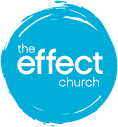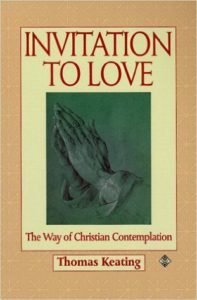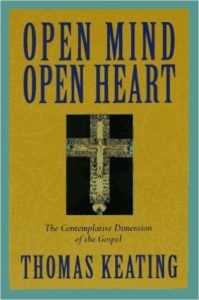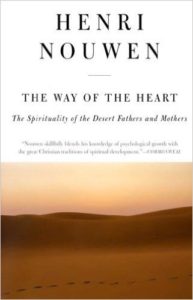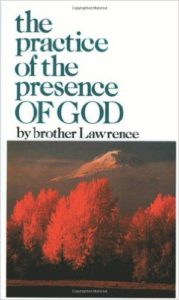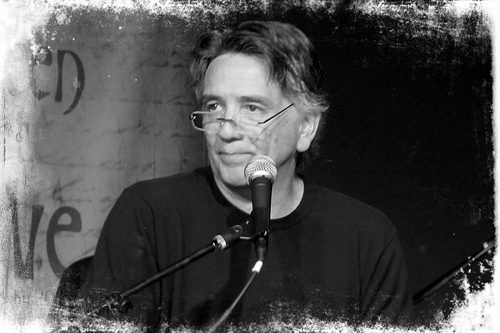We tend to think of prayer as talking to God or listening to God or thinking about God, but rarely do we think of it as resting in God. The long tradition of contemplative prayer that stretches back to the earliest days of Christianity has largely been lost in the West–to the point that in some circles it is seen as somehow dangerous or antithetical to Christianity. Nothing could be further from the truth.
The truth is that God’s native language is silence. How could it be otherwise? Anything from or of God–anything from an infinite dimension–is changed, limited, and distanced the instant we reduce it to mere words or symbols or even thoughts in a finite mind. The only way we can experience all of God is in the silence of resting, spirit to spirit, with him. In those moments we can know something intimately about our God, but we can never speak of it to another without again reducing it something else.
Centering prayer is a relatively recent adaptation of ages of contemplative practice that can help us to find a deeper way to pray. Regular practice will help build a new habit of becoming more aware of God’s presence in every moment of our lives–not just those dedicated to formal prayer. We need to understand that praying continuously is not a continuous string of words or thoughts, but a continuous, unselfconscious awareness of God’s presence–at work and play and conversation and study… Centering prayer can help us find God in all our moments.
resources
Here are some tools and resources to get you started on your contemplative journey:
The four books listed here are great primers on centering prayer and the contemplative life. Thomas Keating is one of the founders of the centering prayer movement, and his books here lay out all the basics. Especially in Invitation to Love, he also describes the emotional and psychological benefits of centering prayer that accompany the spiritiual. The Way of the Heart and Practicing the Presence of God center on the necessity of carving out silence and awareness of God’s presence in a noisy world. [Click on the cover images to go to Amazon’s listing to read more and to order.]
Links to helpful websites:
- Contemplative Outreach. The website for Thomas Keating’s organization has much more information on centering prayer, local groups, retreats, workshops, and resources.
- World Community for Christian Meditation. A worldwide community with many great resources and an extensive bookstore.
- Beliefnet: Lectio Divina. A good primer on Lectio Divina with additional resources from a retreat center in central CA that also offers classes and retreats.
- The Contemplative Way. Website of James Finley, a student of Thomas Merton, and an author, retreat leader, Merton scholar, and master of contemplative spirituality.
- Below is a distillation of the method of centering prayer from Thomas Keating’s books and the Contemplative Outreach website, with some editorializing from us. Take a look and begin your own practice and see where it leads.
- If you have more questions, or want to discuss these issues, contact Pastor Dave by email or phone.
centering prayer method
The practice of resting in the presence of God’s spirit has always been a traditional form of prayer in Christianity. But as we as a people became more focused on rational thought over the last 500 years or so, our prayer forms have become more rational as well–grounding our prayer in words and mental images.
These words and mental images–our very thoughtforms–form the walls of our ego, a perceived self that keeps us feeling separated from each other and from God. This sense of self, the voice in our minds, is always at work keeping us isolated from immersion in the present moment.
If we can learn to quiet our minds, to rest in the stillness and silence of God’s presence during our prayer time, we will have learned the skills we need bring that silence into each moment of our daily lives. Prayer time as training ground to bring God’s presence and oneness into each moment–practicing the presence of God–is what praying without ceasing really means, and what Jesus meant by living in Kingdom.
What follows here is the method of the modern practice of centering prayer developed by three Trappist monks on the foundations of ancient Christian practices. Try bringing this form of prayer into your daily prayer life and from there into your daily life. See what begins to happen as your moments become characterized by Kingdom.
Contemplative Prayer
We may think of prayer as thoughts or feelings expressed in words. But this is only one expression. In the Christian tradition Contemplative Prayer is considered to be the pure gift of God. It is the opening of mind and heart–our whole being–to God, the Ultimate Mystery, beyond thoughts, words, and emotions. Through grace we open our awareness to God whom we know by faith is within us, closer than breathing, closer than thinking, closer than choosing – closer than consciousness itself.
Centering Prayer
Centering Prayer is a method designed to facilitate the development of Contemplative Prayer by preparing our faculties to receive this gift. It is an attempt to present the teaching of earlier times in an updated form. Centering Prayer is not meant to replace other kinds of prayer: rather it casts a new light and depth of meaning on them. It is at the same time a relationship with God and a discipline to foster that relationship. This method of prayer is a movement beyond conversation with Christ to communion with Him.
Centering Prayer is based on the wisdom saying of Jesus in the Sermon on the Mount: “…But when you pray, go to your inner room, close the door and pray to your Father in secret. And your Father, who sees in secret, will repay you.” (Matthew 6.6) It is also inspired by writings of major contributors to the Christian contemplative heritage including John Cassian, the anonymous author of The Cloud of Unknowing, Francis de Sales, Teresa of Avila, John of the Cross, Thérèse of Lisieux, and Thomas Merton.
Centering Prayer Guidelines
- Choose a sacred word as the symbol of your intention to consent to God’s presence and action within.
(cf. Open Mind, Open Heart, chap. 5)- The sacred word expresses our intention to consent to God’s presence and action within.
- The sacred word is chosen during a brief period of prayer asking the Holy Spirit to inspire us with one that is especially suitable for us. Examples: God, Jesus, Abba, Father, Mother, Mary, Amen. Other possibilities: Love, Peace, Mercy, Listen, Let Go, Silence, Stillness, Faith, Trust, Yes.
- Instead of a sacred word a simple inward glance toward the Divine Presence or noticing one’s breath may be more suitable for some persons. The same guidelines apply to these symbols as to the sacred word.
- The sacred word is sacred not because of its inherent meaning but because of the meaning we give it as the expression of our intention and consent.
- Having chosen a sacred word, we do not change it during the prayer period because that would be to start thinking again.
- Sitting comfortably and with eyes closed, settle briefly and silently introduce the sacred word as the symbol of your consent to God’s presence and action within.
- “Sitting comfortably” means relatively comfortably so as not to encourage sleep during the time of prayer.
- Whatever sitting position we choose, we keep the back straight.
- We close our eyes as a symbol of letting go of what is going on around and within us.
- We introduce the sacred word inwardly as gently as laying a feather on a piece of absorbent cotton.
- Should we fall asleep upon awakening we continue the prayer.
- When engaged with your thoughts, return ever-so-gently to the sacred word.
- “Thoughts” is an umbrella term for every perception, including sense perceptions, feelings, images, memories, plans, reflections, concepts, commentaries, and spiritual experiences.
- Thoughts are an inevitable, integral and normal part of Centering Prayer.
- By “returning ever-so-gently to the sacred word” a minimum of effort is indicated. This is the only activity we initiate during the time of Centering Prayer.
- During the course of Centering Prayer, the sacred word may become vague or disappear.
- At the end of the prayer period, remain in silence with eyes closed for a couple of minutes.
- The additional 2 minutes enables us to bring the atmosphere of silence into everyday life.
- If this prayer is done in a group, the leader may slowly recite a prayer such as the Lord’s Prayer while the others listen.
Some Practical Points
- The minimum time for this prayer is 20 minutes. Two periods are recommended each day, one first thing in the morning and the other in the afternoon or early evening. With practice the time may be extended to 30 minutes or longer.
- The end of the prayer period can be indicated by a timer which does not have an audible ticking or loud sound when it goes off. [The timer is really essential. How can you rest in God if you’re wondering when your time is up? A little digital timer that counts down from a set time and that emits a soft tone or beep, sets you free from thinking about time when the goal is not to think at all.]
- Possible physical symptoms during the prayer:
- We may notice slight pains, itches, or twitches in various parts of the body or a generalized sense of restlessness. These are usually due to the untying of emotional knots in the body.
- We may notice heaviness or lightness in our extremities. This is usually due to a deep level of spiritual attentiveness.
- In all cases we pay no attention and ever- so-gently return to the sacred word.
- The principal fruits of the prayer are experienced in daily life and not during the prayer period.
- Centering Prayer familiarizes us with God’s first language which is silence.
Points for Further Development
- During the prayer period, various kinds of thoughts may arise.
- Ordinary wanderings of the imagination or memory.
- Thoughts and feelings that give rise to attractions or aversions.
- Insights and psychological breakthroughs.
- Self-reflections such as, “How am I doing?” or, “This peace is just great!”
- Thoughts and feelings that arise from the unloading of the unconscious.
- When engaged with any of these thoughts return ever-so-gently to your sacred word.
- During this prayer we avoid analyzing our experience, harboring expectations, or aiming at some specific goal such as:
- Repeating the sacred word continuously.
- Having no thoughts.
- Making the mind a blank.
- Feeling peaceful or consoled.
- Achieving a spiritual experience. (cf. Open Mind, Open Heart, chap. 6-10)
Ways to Deepen Our Relationship with God
- Practice two 20-30 minute periods of Centering Prayer daily.
- Listen to the Word of God in Scripture and study “Open Mind, Open Heart.”
- Select one or two of the specific practices for everyday life as suggested in Open Mind, Open Heart,
chap. 12. - Join a weekly Centering Prayer Group.
- It encourages the members of the group to persevere in their individual practices.
- It provides an opportunity for further input on a regular basis through tapes, readings, and discussion.
- It offers an opportunity to support and share the spiritual journey.
What Centering Prayer Is and Is Not
- It is not a technique but a way of cultivating a relationship with God.
- It is not a relaxation exercise but it may be refreshing.
- It is not a form of self-hypnosis but a way to quiet the mind while maintaining its alertness.
- It is not a charismatic gift but a path of transformation.
- It is not a para-psychological experience but an exercise of faith, hope and selfless love.
- It is not limited to the “felt” presence of God but is rather a deepening of faith in God’s abiding presence.
- It is not reflective or spontaneous prayer, but simply resting in God.
Copyright © 1995-2008 Contemplative Outreach Ltd.
